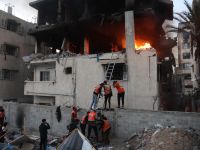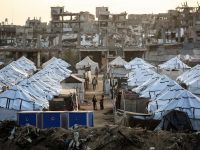By Jon Pattee
Senior English Editor
Albawaba.com
Imagine a land where the water is contaminated with raw sewage and heavy metals, the orchards are bulldozed, the fields are scarred by tanks, the wild animals are hiding, and the songbirds are scattered.
You are looking at Occupied Palestine.
“The movement of tanks, bulldozers and heavy military machinery in most areas has destroyed sensitive plants and the niches of many animals,” Dr. Ramzi M. Sansur, director of the Bir Zeit University Center for Environmental and Occupational Health Services, told Albawaba.com.
The last several months of the Palestinian uprising have seen repeated attacks by Israeli forces on people and property in the Occupied Territories, using everything from tanks and bulldozers to F-16 fighter-bombers.
Besides the loss of life – nearly 600 people killed, the overwhelming majority of them Palestinians – the environment has suffered immeasurably. Moreover, the latest damage only deepens the environmental wounds of three decades of Israeli military occupation.
“The effects of the Israeli activities cannot be measured in such a short term,” says Sansur. “The effects on the environment during such aggressive practices are long-term and often difficult to measure.”
Many wounds are visible right there on the surface. The Bir Zeit center director notes that “the shrubs that protect the soil from erosion” have been uprooted, and “a lot of terraced land in the mountains has been bulldozed.”
“So next winter, soil erosion will be aggravated,” says the Palestinian environmentalist.
But erosion threatens only the surviving plants and trees – and the Palestinian Authority (PA)’s Ministry of Agriculture estimates that roughly 25,000 olive and fruit trees have already been uprooted by the occupation forces.
At least one Israeli spokesman, quoted in a February article by the Environment News Service, was unapologetic about the destruction.
"The orchards are used for cover for offensive attacks," he told the agency, and "by taking them down there is more space for keeping an open ground for protection."
Meanwhile, the widespread flattening of orchards and bulldozing of fields has taken its toll on wildlife.
According to Sansur, “nesting birds and in particular song birds” have been the most affected by the fighting.
“This is the nesting season,” notes the Bir Zeit environmentalist. “In addition, small ground and predatory mammals are very vulnerable.”
Less Than Zero
War means bad news for Palestine’s environmentalists, who after three decades of Israeli military occupation are standing a good bit to the rear of square one.
”Whereas in the last twenty years Israel has been improving its environmental awareness and promulgated laws and regulations aiming at protecting the environment to meet international standards, it has not extended the benefit of this move to the Occupied Territories,” notes a massive report issued last year by the Palestinian Society for the Protection of Human Rights and the Environment (LAW).
“The overall situation in Palestine is alarming,” states the report, which arrived last January, even before the most recent uprising sent the environment into a tailspin.
“Untreated wastewater is flowing freely in the valleys and on agricultural land. Solid waste dumping sites are numerous and scattered all over the area, none of them filling basic sanitary requirements. Because of a lack of environmental infrastructure, solid waste that is not collected regularly is often burned by the inhabitants, resulting in the emanation of toxic fumes in populated areas.”
In the report, An Overview of the Consequences of Israeli Occupation on the Environment in the West Bank and Gaza, LAW highlights the fact that Palestinians still have no saying in the administration of their water resources.
“These same scarce resources are increasingly saline because of over-exploitation and pollution from different sources, among them unregulated use of pesticides and mismanagement of solid and liquid waste.”
Added to this chemical cocktail, Palestinians may find the fruits of Israel’s most recent attacks in their wells.
“The weapons fired have toxic explosive residues such as TNT and heavy
metals that could leach into the aquifers,” says Sansur.
Purifying this water could be a long way off, given the current conflict. The stored material for one new wastewater treatment plant was a target for two Israeli rockets, according to PA Ministry of Environmental Affairs sources, as quoted by the Environment News Service.
In fact, things are tough all over for Palestinian environmentalists, and the Bir Zeit Center for Environmental and Occupational Health Services is no exception.
The environmental center’s stated goal is to build “an informed society with the right to know and choose,” while taking a “multi-sector approach targeting farmers, their families, industry and consumers.” But the occupation and the recent conflict have made it rough going.
“We are unable to reach our target communities where we offer our
environmental education and demonstration programs,” Sansur told Albawaba.com. “Our Integrated Pest Management greenhouse demonstration station collapsed and all the plants died as we could not reach it. Our IPM produce could not be marketed due to severe restrictions on movement.”
To top it off, says the center director, “Our analytical services are on the verge of collapse, because our customers are in a bad economic situation…[and] most funds from donors have been frozen.”
With tanks and bulldozers crisscrossing the land, Sansur is struggling to glimpse the light at the end of the tunnel for Palestine’s wildlife and ecosystem.
“I am always hopeful,” says the environmentalist. “But I consider the Israeli strategies in Israel and Palestine as environmentally behind the times, or what are termed as retarded policies.”







